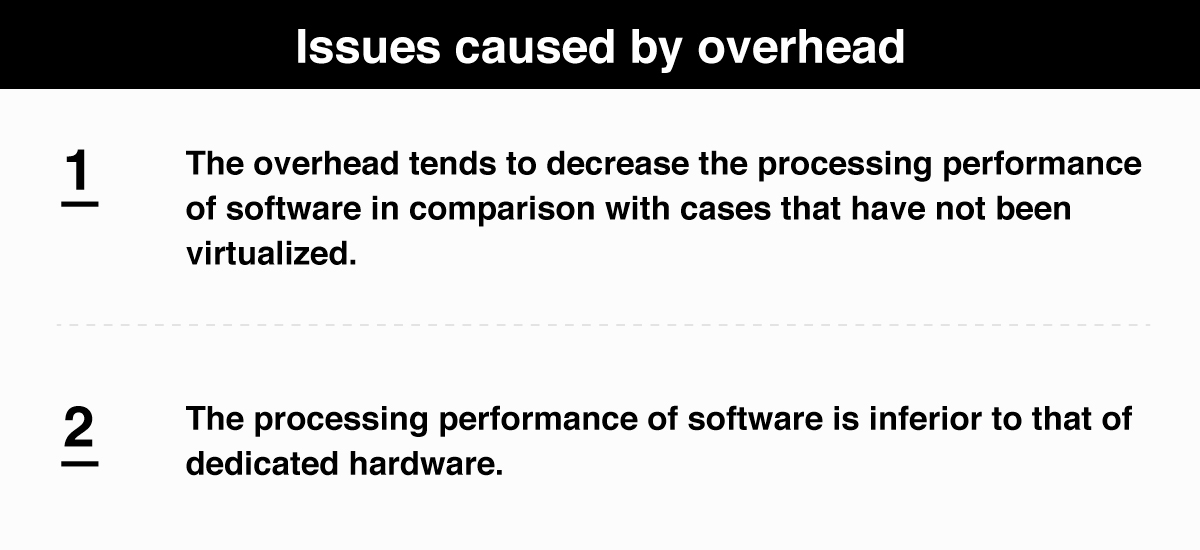Blogs
- Feb 22, 2023
- Blog
- Wireless
Our Initiative to “Virtualize” 5G Base Stations
#AI-RAN
Scroll
5G (5th generation mobile communication system) is expected to deliver high-speed, and large-volume communications with low latency. The Research Institute of Advanced Technology has been conducting R&D activities with the aim of “virtualizing” 5G base stations, which is the separation of the 5G base station’s physical functions using software.
The Advantages and Disadvantages of Virtualization
Up until now, products by manufacturers of Radio Access Networks (RANs) and mobile core networks, which enable mobile phone connections, have been sold as a bundle with dedicated hardware and software.
However, with the advancement of virtualization technologies, standard commercial-off-the-shelf (COTS) servers can now be used for hardware.
The benefits of virtualization include improved maintainability and cost reduction by using COTS products for hardware , and enhanced flexibility of software.
This has created a trend towards the virtualization of base stations in the telecommunications industry.
However, the vast amount of computation required for the virtualization of base stations has been a cause for concern. The baseband unit (BBU or DU/CU) of a base station performs signal processing in real-time. The amount of its computation rises at an exponential rate depending on the frequency bandwidth and the number of MIMO layers, and requires a high degree of computing performance.
Additionally, there are also issues that arise from “overhead” (tasks requiring higher computational costs) that occurs by the separation of hardware and software resulting from virtualization.

“Accelerators” Required for Processing Vast Amounts of Computation
“Accelerators” are expected to improve performance by meeting the heavy processing requirements, which is a concern at base stations, while avoiding the common challenges of virtualization.
By using accelerators, heavy processing can be offloaded to hardware and improve the processing performance of software.

The Research Institute of Advanced Technology is conducting verifications of virtualization using GPUs from the perspective of applying it to “Edge Computing,” in which servers are dispersedly located near devices.
GPUs have the following two characteristics.
(1) Highly versatile
A SDK called “CUDA” is provided for software development using GPUs. This enables the length of the development cycle to be reduced in comparison to cases in which commonly used “FPGAs (Field Programmable Gate Arrays)” are used. Since there is also an abundant collection of libraries that compile commonly used programming functions, it is easy to use them for applications other than RAN.
(2) Enables effective utilization of resources through virtualization
With the technology to divide a single GPU and allocate it to multiple processes or virtual machines, it enables more flexible use of resources. For example, when the load on the RAN is relatively low, other resources can be allocated and effective utilization of computational resources can be expected.
Tests Carried Out in The Past
We have performed verification tests to evaluate the suitability of GPUs as accelerators for “vRAN” (virtualized radio access networks), which virtualize the RAN. During these tests, latency and power consumption were analyzed in the “L1 block※”, which generally involves a heavy processing load, and GPUs proved to be capable of sufficient processing performance.
- ※L1 block: A part of the 5G RAN function. Responsible for functions such as the encoding/decoding of signals, multiplexing of physical layers, and error detection.
Furthermore, at the “AI-on-5G Lab.”, a research facility opened in July 2022, we successfully demonstrated an “end-to-end (E2E)” connection between two parties communicating with each other while utilizing “over-the-air (OTA)” technology to send and receive data via wireless communications. Videos were uploaded to an artificial intelligence (AI) application via 5G networks and the images were analyzed in real time with an AI application.

As the commercialization of virtualized 5G base stations progresses in the future, it is expected that the dedicated hardware infrastructure for RAN will become obsolete, while the existing hardware infrastructure for AI applications currently used in stores and facilities will be utilized to enable the provision of private 5G services for enterprises.
To make this possible, the Research Institute of Advanced Technology will continue to work on the research and development of virtualized radio access networks.
- 22.02.2023
- Next-Generation Batteries
SoftBank’s Next-Generation Battery Development

